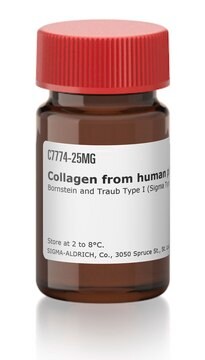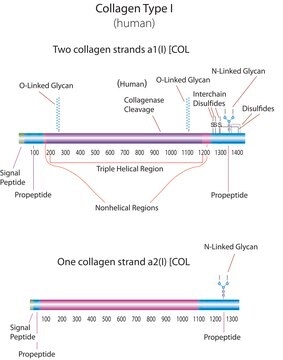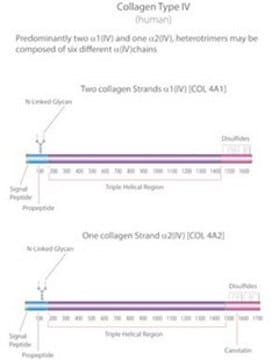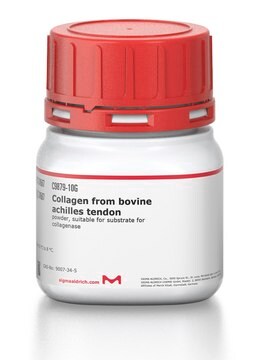C7624
Collagen human
Bornstein and Traub Type I, recombinant, expressed in Nicotiana tabacum (tobacco)
Synonyme(s) :
Collage™
About This Item
Produits recommandés
Source biologique
human
Niveau de qualité
Produit recombinant
expressed in Nicotiana tabacum (tobacco)
Pureté
>90% (SDS-PAGE)
Forme
liquid
Concentration
2.5-3.5 mg/mL protein (Sircol method)
Technique(s)
cell culture | mammalian: suitable
Conditions d'expédition
wet ice
Température de stockage
2-8°C
Informations sur le gène
human ... COL1A1(1277) , COL1A2(1278)
Vous recherchez des produits similaires ? Visite Guide de comparaison des produits
Description générale
Forme physique
Notes préparatoires
To prepare a collagen gel the fibrillogenesis buffer contains 162 mM sodium phosphate dibasic (Na2HPO4) adjusted to pH 11.2 with 10 N NaOH, filter sterilized. Mix 9 volumes of Collagen at a concentration of 0.3%-1% with 1 volume of fibrillogenesis buffer. Mix well and incubate for 4 to 16 hours at 25°C to 27 °C. Higher concentration of collagen solution might need optimization. Thiis preparation will not spontaneously form a gel in PBS or cell culture medium.
Preparation of collagen sponge: concentrate gel to 10 mg/ml - 100 mg/ml by centrifugation, freeze dry. Crosslink by common methods found in the scientific literature such as 1-Ethyl-3-[3-dimethylaminopropyl]carbodiimide hydrochloride (EDC), Glutaraldehyde or thermal dehydration.
Other forms: membranes, sheets, fibers can be prepared by methods commonly used with other types of collagen.
Informations légales
Code de la classe de stockage
13 - Non Combustible Solids
Classe de danger pour l'eau (WGK)
nwg
Point d'éclair (°F)
Not applicable
Point d'éclair (°C)
Not applicable
Certificats d'analyse (COA)
Recherchez un Certificats d'analyse (COA) en saisissant le numéro de lot du produit. Les numéros de lot figurent sur l'étiquette du produit après les mots "Lot" ou "Batch".
Déjà en possession de ce produit ?
Retrouvez la documentation relative aux produits que vous avez récemment achetés dans la Bibliothèque de documents.
Les clients ont également consulté
Notre équipe de scientifiques dispose d'une expérience dans tous les secteurs de la recherche, notamment en sciences de la vie, science des matériaux, synthèse chimique, chromatographie, analyse et dans de nombreux autres domaines..
Contacter notre Service technique











